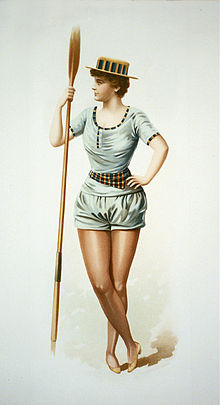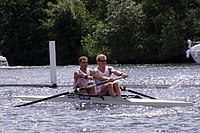This is an old revision of this page, as edited by Whizz40 (talk | contribs) at 20:36, 29 March 2015 (copy text from Rowing (sport)#Women and create a History section). The present address (URL) is a permanent link to this revision, which may differ significantly from the current revision.
Revision as of 20:36, 29 March 2015 by Whizz40 (talk | contribs) (copy text from Rowing (sport)#Women and create a History section)(diff) ← Previous revision | Latest revision (diff) | Newer revision → (diff)

Women's rowing is the participation of women in the sport of rowing.
Women have competed in rowing events as far back as the fifteenth century. When Beatrice d'Este visited Venice in 1493, a regatta was held in which fifty peasant women competed. Later, in the 19th century, Ann Glanville led a team of fisherwomen from Saltash in various regattas, becoming known as the champion female rower of the world.
The Leander Club, which is one of the oldest rowing clubs in the world, was opened to women in 1998 and appointed Olympic medallist, Debbie Flood, as its captain in 2012.
History
For most of its history, rowing has been a male dominated sport. Although rowing's roots as a sport in the modern Olympics can be traced back to the original 1896 games in Athens, it was not until the 1976 Summer Olympics in Montreal that women were allowed to participate — well after their fellow athletes in similar sports such as swimming, athletics, cycling, and canoeing.
Despite its male domination, women's rowing can be traced back to the early 19th century, and an image of a women's double scull race made the cover of Harper's Weekly in 1870. Wellesley College in Massachusetts was the first school to organize a competitive rowing team for women in the late 19th century. The 19th Century Cornish rower Ann Glanville achieved national celebrity; her all-women crew often winning against the best male teams. In 1892, four young women started what became ZLAC Rowing Club in San Diego, California, which is recognized today as the world's oldest continuously existing all-women's rowing club.Link In 1927, the first rowing event for women between Oxford and Cambridge was held. For the first few years it was an exhibition, and it later became a race. Ernestine Bayer, called the "Mother of Women's Rowing", formed the Philadelphia Girls' Rowing Club in 1938.
In 1954, the first women's events were added to the European Rowing Championships. In 1988, the first Henley Women's Regatta was held. Henley Royal Regatta first included a women's singles event over the full course in 1993, followed in 2000 by eights (now Remenham Challenge Cup) and 2001 by quadruple sculls (now Princess Grace Challenge Cup). On April 27, 1997, one of the last bastions of rowing was breached when, at an Extraordinary General Meeting, Leander Club voted to admit women as members. This rule met a condition imposed by UK Sport and qualified Leander to receive a £1.5 million grant for refurbishment from the Lottery Sports Fund.
At the international level, women's rowing traditionally has been dominated by Eastern European countries, such as Romania, Russia, and Bulgaria, although other countries such as Germany, the Netherlands, Canada, and New Zealand often field competitive teams. The United States also has had very competitive crews, and in recent years these crews have become even more competitive given the surge in women's collegiate rowing due to Title IX. Because Title IX mandates equal money spent on men's and women's sports, rowing is particularly useful due to the extremely high costs of equipment per athlete. Therefore, many schools open a rowing program only to women to financially counteract the prevalence of men's sports. In the United States, it is important to note that Women's Rowing is an NCAA sport, while Men's Rowing chooses to remain governed by its own regulatory body, the Intercollegiate Rowing Association (IRA). The IRA, formed in 1895, preceded the NCAA by at least ten years and provided a guideline for the rules of eligibility and sportsmanship later adopted by the NCAA when it was formed.
See also
References
- ^ Schweinbenz, Amanda (2014), "Against Hegemonic Currents: Women's Rowing in the First Half of the Twentieth Century", Women in Sports History, Routledge, pp. 124–125, ISBN 9781317985235
- Leander rowing club elects Debbie Flood as first female captain, BBC News, 8 December 2012
- http://www.sense-of-place.co.uk/AnnGlanville/previewFlash.html
- "Leander voted for women". REGATTA OnLine. Retrieved 2006-12-23.
| Rowing | ||
|---|---|---|
| Australian rowing |  | |
| Canadian rowing | ||
| New Zealand rowing | ||
| UK rowing |
| |
| Henley Royal Regatta | ||
| US rowing | ||
| World Rowing events | ||
| Types of rowing | ||
| Lists | ||
This rowing-related article is a stub. You can help Misplaced Pages by expanding it. |